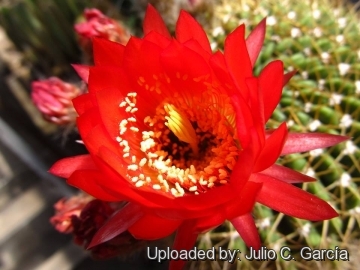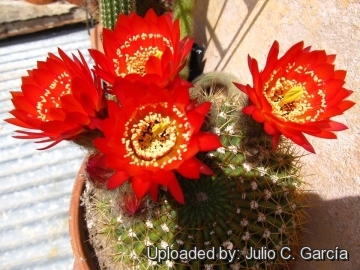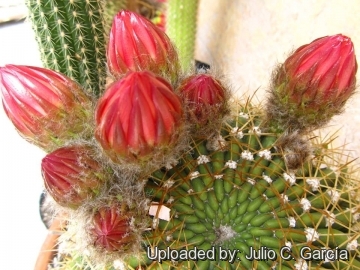
Echinopsis bruchii Photo by: Flavio Agrosi
Origin and Habitat: Northern Argentina (Catamarca, Jujuy, La Rioja, Mendoza, Salta, San Juan) .
Altitude: It grows at elevations of 1700-3500 meters above sea level.
Habitat: The species has a patchy distribution but is locally abundant in high altitude in puna and prepuna grasslands, monte shrubland, and altos andes among large boulders on flats, slopes and ridges, together with other succulent plants like Lobivia schreiteriSN|16340]]SN|16340]] and Parodia tafiensisSN|11761]]SN|11761]].
Synonyms:
See all synonyms of Echinopsis bruchii
back
Accepted name in llifle Database:Echinopsis bruchii (Britton & Rose) Friedrich & GlaetzleBradleya 1: 96. 1983Synonymy: 37
back
Common Names include:
ENGLISH: Golden Barrel of the Andes
Description: Echinopsis bruchiiSN|48]]SN|2530]] (still known in cultivation as Lobivia bruchiiSN|2531]]SN|2531]] or Soehrensia bruchiiSN|2533]]SN|2533]]) is one of the larger Echinopsis species, the multi-ribbed bodies grow to as much as 50 cm thick. It has yellow or brownish-orange spines and brilliantly red blossoms. It is a morphologically variable taxon growing widespread in the mountains of Argentina and has received numerous unnecessary names.
Similar species: The status of Echinopsis bruchiiSN|48]]SN|2530]] is controversial and some do not consider it an independent species, but a subspecies of Echinopsis formosaSN|2530]]SN|48]] (Echinopsis formosaSN|2530]]SN|48]] subs. Bruchii) which form a multiform complex, where each form is linked to others by populations of plants with intermediate characteristics.
Habit: Plants usually solitary round or barrel-shaped, occasionally clustering.
Stem: Globular, 20-30(-50) cm in diameter, becoming elongate or cylindrical with age 0,5-0,7(- 2) m tall, glossy dark green and more or less depressed in the centre.
Ribs: 15-50 or more, distinct but low, more or less inflated or tuberculate between areoles.
Areoles: Filled with short white wool.
Spines: Several, spreading, usually yellowish or brown, those of the upper areoles connivent.
Central spines: 2-4.
Raduial spines: 8-10
Flowers: Diurnal, small, at areoles below the apex of plant, 4-5(-8) cm long and 4-5 cm in diameter, deep red to orange; tube of flower short, its axils filled with wool; inner perianth-segments lanceolate, slightly spreading; filaments exserted beyond the throat, but shorter than the perianth-segments.
Blooming season: Spring to summer. Flowers last for 1 to 3 days (depending on weather condition).
Subspecies, varieties, forms and cultivars of plants belonging to the Echinopsis bruchii group
 Echinopsis bruchii (Britton & Rose) Friedrich & Glaetzle: is one of the larger Echinopsis species, the multi-ribbed bodies grow to as much as 50 cm thick. It has yellow or brownish-orange spines and brilliantly red blossoms. Distribution: Northern Argentina.
Echinopsis bruchii (Britton & Rose) Friedrich & Glaetzle: is one of the larger Echinopsis species, the multi-ribbed bodies grow to as much as 50 cm thick. It has yellow or brownish-orange spines and brilliantly red blossoms. Distribution: Northern Argentina.- Echinopsis bruchii f. albiflora (Y.Itô): White flowering form.
- Echinopsis bruchii f. brevispina (F.Ritter): has shorter spines. Distribution: Tafi del Valle, Tucumán, Argentina.
 Echinopsis bruchii var. nivalis (Frič) Rausch: has mostly yellowish or whitish pines and red blooms and grows in high altitude (3800-4100 asl). Distribution: Northern Argentina (Jujuy, Salta) .
Echinopsis bruchii var. nivalis (Frič) Rausch: has mostly yellowish or whitish pines and red blooms and grows in high altitude (3800-4100 asl). Distribution: Northern Argentina (Jujuy, Salta) .- Echinopsis grandis (Britton & Rose) H.Friedrich & G.D.Rowley
- Echinopsis ingens (Backeb.) H.Friedrich & G.D.Rowley
Bibliography: Major references and further lectures
1) Edward Anderson “The Cactus family” Timber Press, Incorporated, 2001
2) James Cullen, Sabina G. Knees, H. Suzanne Cubey "The European Garden Flora Flowering Plants: A Manual for the Identification of Plants Cultivated in Europe, Both Out-of-Doors and Under Glass" Cambridge University Press, 11/Aug/2011
3) David R Hunt; Nigel P Taylor; Graham Charles; International Cactaceae Systematics Group. "The New Cactus Lexicon" dh books, 2006
4) Friedrich Ritter "Kakteen in Südamerika: Ergebnisse meiner 20jährigen" Volume 2, Argentinien/Bolivien, Volume 2 Selbstverlag, 1980
5) Curt Backeberg “Die Cactaceae: Handbuch der Kakteenkunde,” Volume 2 G. Fischer, 1959
6) N. L. Britton and J. N. Rose “The 'Cactaceae', Descriptions and Illustrations of Plants of the 'Cactus' Family” volume 2 Carnegie Institution, 1920
7) Hans Hecht “BLV-Handbuch der Kakteen” BLV-Verlagsgesellschaft, 1982
8) Haustein, Erik. “Der Kosmos-Kakteenführer.” Kosmos / Gesellschaft der Naturfreunde., Stuttgart, 1983
9) Urs Eggli, Leonard E. Newton “Etymological Dictionary of Succulent Plant Names.” Springer, Berlin/Heidelberg 2010
 Echinopsis bruchii Photo by: Julio C. García
Echinopsis bruchii Photo by: Julio C. García Echinopsis bruchii Photo by: Julio C. García
Echinopsis bruchii Photo by: Julio C. García Echinopsis bruchii Photo by: Julio C. García
Echinopsis bruchii Photo by: Julio C. GarcíaSend a photo of this plant.The gallery now contains thousands of pictures, however it is possible to do even more. We are, of course, seeking photos of species not yet shown in the gallery but not only that, we are also looking for better pictures than those already present.
Read More... Cultivation and Propagation: Echinopsis bruchiiSN|2530]]SN|2530]] is one of the more cold hardy barrel cacti, that tolerates
in winter both, ice, snow, hail, and rain and temperatures down to – 12° C
Growth rate: It is a relatively rapidly growing species that will make clumps given the best conditions.
Soils: It likes very porous standard cactus mix soil. Prefer a low pH compost, avoid substrata rich in limestone; otherwise growth will stop altogether.
Repotting: This plant needs plenty of space for its roots, repotting should be done every other year or when the it has outgrown its pot. Use pot with good drainage.
Watering: Needs moderate to copious waterings in summer, but do not overwater (Rot prone), keep dry in winter at a minimum temperature of 0°C.
Fertilization: Feed with a high potassium fertilizer in summer.
Hardiness: Reputedly resistant to frost if kept on the dry side prior to, and during, cold weather (hardy to -12 C ° C, or less for short periods). Zone 8b to 10
Exposition: The plant tolerates extremely bright situations which encourages flowering and heavy spine production, but is likely to suffer from sun scorch or stunted growth if over exposed to direct sunlight during the hottest part of the day in summer. It may tolerate filtered sunlight or afternoon shade.
Uses: It is an excellent plant for container growing. It always looks good and stays small. It look fine in a cold greenhouse and frame or outdoor in a rockery.
Pests & diseases: It may be attractive to a variety of insects, but plants in good condition should be nearly pest-free, particularly if they are grown in a mineral potting-mix, with good exposure and ventilation. Nonetheless, there are several pests to watch for:
- Red spiders: Red spiders may be effectively rubbed up by watering the plants from above.
- Mealy bugs: Mealy bugs occasionally develop aerial into the new growth among the wool with disfiguring results, but the worst types develop underground on the roots and are invisible except by their effects.
- Scales: Scales are rarely a problem.
- Rot: This species is particularly easy and accommodating, seldom suffer of cryptogamic diseases. Rot it is only a minor problem with gymnocalyciums if the plants are watered and “aired” correctly. If they are not, fungicides won't help all that much.
Propagation: Division of larger clumps, direct sow after last frost. Seeds germinate in 7-14 days at 21-27° C in spring, remove gradually the glass cover as soon the plants will be well rooted (ca 1-2 weeks) and keep ventilated, no full sun for young plants! To make a cutting twist off a branch and permit it to dry out a couple of weeks, lay it on the soil and insert the stem end partially into the soil. Try to keep the cutting somewhat upright so that the roots are able to grow downward.













